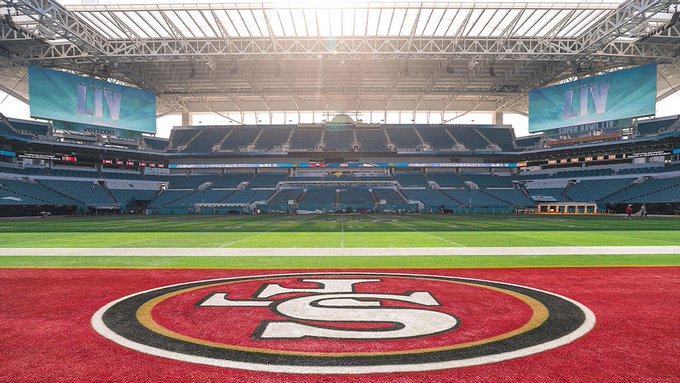
In the 10 years since its last Super Bowl, Hard Rock Stadium has changed considerably, transitioning from a typical multipurpose stadium to a venue that reflects the modern NFL gameday experience.
Home to the Miami Dolphins, the current Hard Rock Stadium has gone by many names—opening as Joe Robbie Stadium in 1987, then later going through a variety of naming-rights sponsorships from Pro Player in the mid-1990s to Sun Life Stadium during its last Super Bowl and for a few years beyond. The venue’s current name went into effect in 2016, in the middle of a major renovation led and financed by Dolphins owner Stephen Ross.
During the years-long renovation—which reportedly cost over $500 million—the Miami Gardens-based stadium has changed considerably. When it first opened, Joe Robbie Stadium provided a solid setup for an NFL franchise, while reflecting its era by being designed to allow for future renovations to accommodate Major League Baseball. The Miami area lacked an MLB franchise at the time, but the venue would indeed land a team when the expansion Florida Marlins debuted in 1993.
Despite the presence of an MLB team, the stadium was never quite optimized for the Marlins, who after years of searching for a new ballpark left the facility following the 2011 season to open Marlins Park in Miami’s Little Havana. By then, the stadium was also lagging in comparison to newer NFL facilities—including those that regularly compete with South Florida for the Super Bowl—prompting a major renovation project.
Renovations got into full swing with seating upgrades in 2015, while the following year saw perhaps the biggest addition in Hard Rock Stadium’s history: a canopy structure that covers much of the seating bowl, providing protection to most fans while leaving the playing surface open to the elements. Throughout the course of the renovation project, the Dolphins also enhanced Hard Rock Stadium’s concessions and premium areas. Technology has also been a major part of that process, including four corner videoboards added in 2016 and this season’s installation of a continuous LED ribbon display that, at 2,105 feet, measures as the longest in professional sports.
While undertaking the renovation project, the Dolphins also adopted a strategy that has seen plenty of non-football events staged at Hard Rock Stadium. Offseason staples such as concerts and soccer matches are part of this trend, but the organization has taken it a step further through events like the annual Miami Open tennis tournament—which it hosted last spring for the very first time.
The area surrounding Hard Rock Stadium has also been remade. A new gondola ride is set to debut on Super Bowl Sunday, providing riders a birds’ eye view of Hard Rock Stadium and the surrounding area. (Note: the gondola ride does not serve as a transit option to and from the stadium but is meant as an attraction for visitors.) Additionally, the Dolphins are currently constructing a new training complex that is scheduled to open in 2021.
Certainly, Hard Rock Stadium has come long way since its last Super Bowl. When the San Francisco 49ers and Kansas City Chiefs take the field on Sunday, it will be in a venue that has been drastically modernized. This weekend’s Super Bowl is unlikely to be its last, even with toughening competition that includes new stadiums in Las Vegas and Los Angeles opening this year, as Hard Rock Stadium’s modernization should make a suitable home to the Dolphins, University of Miami football, and other major events for years to come.
Image courtesy San Francisco 49ers.
This article first appeared in the weekly Football Stadium Digest newsletter. Are you a subscriber? It’s free, and you’ll see features like this before they appear on the Web. Go here to subscribe to the Football Stadium Digest newsletter.
